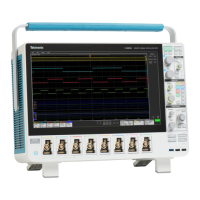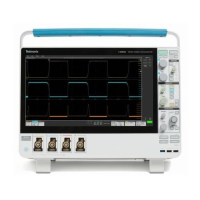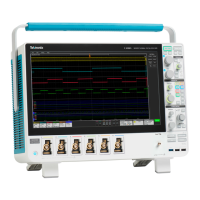Commands listed in alphabetical order
ACQuire:SEQu
ence:NUMSEQuence
In single sequence acquisition mode, specify the number of acquisitions or
measurements that comprise the sequence. The default is 1.
Group
Acquisition
Syntax
ACQuire:SEQuence:NUMSEQue nce <NR1>
ACQuire:SEQuence:NUMSEQue nce?
Arguments
<NR1> is the number of acquisitions or measurements that comprise the sequence.
Examples
ACQUIRE:SEQUENCE:NUMSEQUE NCE 2 sets the number of acquisition in a
sequence is set to 2.
ACQUIRE:SEQUENCE:NUMSEQUE NCE? might return
:ACQUIRE:SEQUENCE:NUMSEQUENCE 1 indicating that the number of
acquisition in a sequence is set to 1.
ACQuire:STATE
This command starts or s tops acquisitions. When state is set to ON or RUN, a
new acquisition will be started. If the last acquisition was a single acquisition
sequence, a n ew single sequence acquisition will be started. If the last acquisition
was continuous, a new continuous acquisition will be started.
If RUN is issued in the middle of completing a single sequence acquisition (for
example, averaging or enveloping), the acquisition sequence is restarted, a
nd
any accumulated data is discarded. Also, the instrument resets the number of
acquisitions. If the RUN argument is issued while in continuous mode, a reset
occurs and acquired data continues to acquire.
If acquire:stopafter is SEQUENCE, this command leaves the instrument in single
sequence, unlike the run/stop button which takes the instrument out of single
sequence.
Group
Acquisition
Syntax
ACQuire:STATE {<NR1>|OFF|ON|RUN|STOP}
ACQuire:STATE?
Related Commands
ACQuire:STOPAfter
2-98 MSO54, MSO56, MSO58, MSO58LP Programmer

